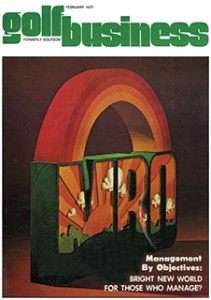The Golfdom Files: Golf business in Japan: taking lessons from U.S.?
Professionals and enthusiasts alike wonder where it is that golf will next take hold, and bring more players into the sport. Many look to Asia and the billions of potential players in India and China. Maybe it’s Brazil, the host country of the upcoming 2016 Olympics, featuring golf’s return to the games. ¶ If you go back more than 40 years, Japan was the booming golf country. In the February 1977 Golf Business (Golfdom’s name during an identity crisis), Mac Hunter took a closer look at the golf industry on the island nation. ¶ The sport is not as popular in Japan today, but it still has some hold on the country. Four Japanese golfers are currently in the World Golf Rankings top 100. Only one of them was alive at the time this article was published, and the top ranked, No. 16 Hideki Matsuyama, was born in 1992. ¶ Who knows, maybe someday we will look at Anirban Lahiri of India, currently the world’s No. 35 ranked golfer, as we now look at Japan’s Torakichi (Pete) Nakamura, who started his country’s own golf boom.
 Golf is a brisk business in Japan — at least until it comes down to the business of playing it.
Golf is a brisk business in Japan — at least until it comes down to the business of playing it.
Indeed, one jet-age connotation applicable to The Land of The Rising Sun is that for an enthusiast to play some of Japan’s 1,000 courses, he’s going to have to greet the sun as it peeks over Mt. Fuji. Japanese golfers are, to put it succinctly, backed up to the teahouse. It may be the only place in the world where a man would need to call to get a starting time on the practice tee.
But the Japanese aren’t complaining. They happily and homogenously accept conditions as they exist because since the beginning of the “Gorufu” boom they haven’t known conditions any different. So what if many of Japan’s 16 million golfers rarely swing a club at any place other than her 5,000 driving ranges? So what if many of those driving ranges are three-decked enclosed edifices where a man simply hits a ball into a net at fairly close range? That’s okay, too.
They are keen students of the game. They will drive for miles just to see an American give an exhibition, which, apart from osmosis and voracious reading, is one of the few methods available to them for learning the techniques of the swing.
How did it begin?
Golf came to trade-conscious Japan through the store window, as opposed to America and England, where the game is rooted in heredity. Mindful of the glut of merchandising that sprang up in this country during the affluent sixties, the perceptive and innovative Japanese businessman saw the potential for it in his country.
Oh, the game existed in Japan before. But only on a very limited rich man’s scale. It had roughly the same patronage in Japan as polo in the U.S. There were possibly 100 courses in Japan in 1957 when Torakichi (Pete) Nakamura scored what was then considered a major upset in the Canada Cup matches by defeating Sam Snead, Gary Player and Dave Thomas of Wales by seven strokes while finishing the tournament 14 under par.
Not long after Nakamura’s victory, the Japanese began to realize that golf, with its mind-over-matter and will-power demands, was ideally suited to their Zen Buddhist philosophy. “… In playing golf a person must learn to control many emotions and make the best expression of himself,” suggested Tokuchika Miki, son of a Zen Buddhist priest.
In the years since, golf has rivaled baseball in Japan for thorough infiltration. Originally a game for millionaires, it reached into the lower echelons of business executives as they saw their bosses play and then got invited to play themselves. Finally, it has filtered into the working class with the construction of driving ranges.
It is a sport that seems to be rising just like the sun.










